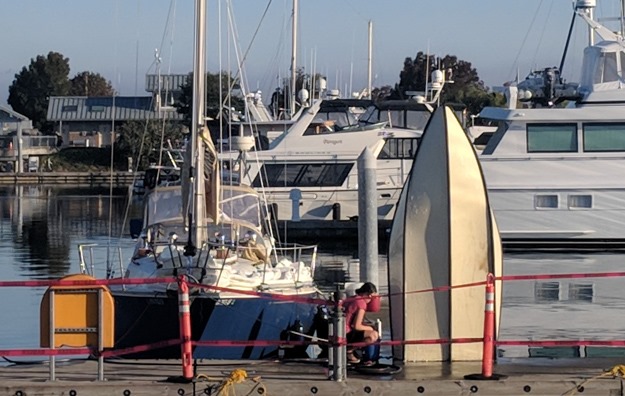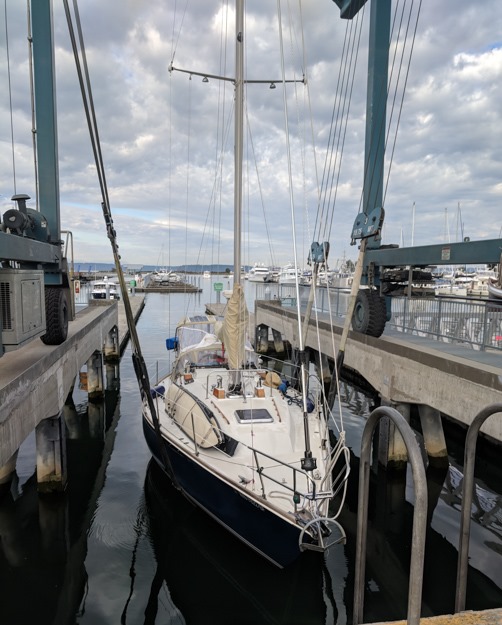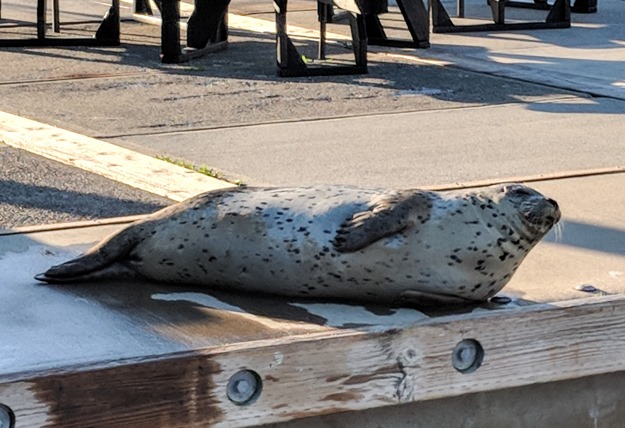Surprisingly few large boats are winterized on the hard in the Pacific Northwest, as is standard practice in other areas where the water freezes (New England, the Great Lakes). We have the luxury of not having to; the relatively steady ~50 F water temperature prevents engines from freezing or harbors icing over. And we have the option of year-round sailing – although much of the winter is pretty rainy and dark, we always have some stretches of sunny, 45-55F weather (positively balmy!).
Yet there are some advantages to storing your boat on land (“on the hard”) – less bottom paint wear, no dock line chafe, etc. So this year we went this route, given we’re traveling for the winter and won’t be able to use our boat. Debating the pros/cons of storing in the water vs on the hard, it was hard to find much information specific to the PNW.
Even though many boats never leave the dock in the winter, their owners still choose to leave them in the water, paying significantly higher moorage costs. This is perplexing, but I guess it boils down to convenience – it takes a bit of work to winterize a boat, and there isn’t a huge surplus of winter storage yards in the Seattle area.
Perhaps another deterrent is that most storage yards have a couple neglected, derelict boats that have been there for years. In some cases, yards are where boats go to die – and this can be very hard to see (not to mention the concerns over their boat catching on fire next to yours). Leaving our boat is a scary thing because not only have we put thousands of hours of work into it, it’s our home now too.
At the end of September we spent several days working to prepare our boat for storage on the hard. There are many articles on winterization (Sailrite, West Marine, Discover Boating), but I’ll cover some things we learned that weren’t mentioned elsewhere, and the checklists we used so we wouldn’t forget things.

Propylene glycol antifreeze for your freshwater system or engine raw water loop
Pros/Cons of Storing in the Water vs On the Hard (“Dry storage”)
The first thing to decide if you’re not going to use your boat for the winter is whether to winterize in the water or on the hard (dry storage – called “dry” only because your hull isn’t in the water – the boat will still be plenty wet from all our rain!).
Storing in the Water
- Less work: no need to winterize the engine, and the water system and toilet can usually be skipped as well (as long as they’re close to the waterline, we’ve never had issues with freezing)
- Ablative bottom paint still wears, bottom growth can occur, and zincs (anodes) deplete
- More location options (there are about 3-4x as many marinas as there are dry storage yards)
Storing on the Hard
- Cheaper
- Impossible for the boat to sink (always unlikely, but it’s nice to not have this concern)
- Boat doesn’t move in storms – this means no worrying about dock line chafe, hull cosmetic damage due to bumpers moving, or needing someone to check on the boat to adjust dock lines.
- Boat may stay drier (especially the hull, but also our bilge always seems drier on the hard than on water)
Costs
If you have the flexibility to go anywhere in the Puget Sound / San Juans region, you have a lot more options for cheaper pricing – by getting further away from Seattle, prices drop. For our 38’ boat, the costs (approximately) are:
- Top-end Seattle marina, per month: $650-700; 5 months: $3250
- Cheaper marina (ex, Everett or Anacortes), per month: $500; 5 months: $2500
- Dry storage, per month: $310 ($300 round-trip haul + ~$250/month); 5 months: $1550
So dry storage saves about $1000 (or more) – well worth two days of work in our view. The longer you plan to store your boat on the hard, the lower the haul-out cost amortizes out to per month. Note: costs are without shore power (we’re using our solar panels to keep the batteries topped up).
One factor I didn’t account for in advance is we needed 1-2 nights in the marina before the haul-out (to dehumidify the boat and do prep we couldn’t do at anchor) and will need 1 or 2 nights after relaunch to get the boat back in order. That adds $40-50/night (up to $200 for 4 nights). This doesn’t apply if you’re moving from a monthly moorage slip or have yacht club reciprocals.
Preparing for Winter
The two biggest concerns we had were moisture (mildew/mold growth) and fire. Fire is always a concern though, whether you’re in the water or on the hard, and you should always have a solid electrical system plus good safety practices.
The other risk is freeze damage to the engine, but that’s an easier worry to address because as long as you take the proper precautions, it’s not a risk at all.
Engine Winterization
Many articles already cover engine winterization. It’s relatively simple, but as with most boat projects, complications arise. The trickiest part for us was how to get the anti-freeze into the raw water intake hose. I pulled the hose off the seacock easily enough, but our engine compartment is very tight – not enough room to fit a bucket down low and the hose doesn’t have enough slack to dip it into a bucket anyway.
So I got an extension hose and connected it with a brass hose coupler (2-way male barbed connector) and hose clamps, placing the extension hose into a 2 gallon bucket of antifreeze.
But that didn’t work – when we started the engine (in the travel lift slings in the work yard), no water came out the exhaust. We often have an airlock issue after hauling out – water gravity drains out the raw water hose and an air bubble forms between the raw water pump and raw water filter. A big pain! In theory the raw water pump should be able to run dry briefly and self prime, but this doesn’t happen on our setup.
When the boat’s in the water I’ve had luck by opening the raw water filter cap and letting sea water push out the air bubble. But this doesn’t work on the hard because there’s no atmospheric pressure pushing water into the raw water hose. So after 30 minutes of futile attempts, I brought the antifreeze to a different point in the system. I disconnected the hose from the raw water filter outlet (the hose that leads to the pump), stuck that in a bucket of antifreeze, and ran the engine. That worked and we got pink antifreeze out the exhaust.
To protect the raw water filter I just poured antifreeze into it – the hose below the filter gravity drains, so any raw water was already pushed out.
Mold Prevention
We’ve written previously about how bad mold can be on a boat (“Tackling the Mold Monster”). The best preventative is to live on your boat (like we did last winter) – a warm boat with a dehumidifier is a happy boat – but that’s not possible for us this year. We debated leaving our trusty dehumidifier running 24/7 with the outlet hose fed into the galley sink drain. But that’s a bit of an electrical / fire hazard risk. The risk is probably very low, but I feel fire is the single biggest risk to boats and not a risk worth taking.
Plus we’ve had luck in prior winters (2016/2017) with our other mold prevention strategy:
- Damprid – we got 1 big bucket and 3 smaller bins that have activated charcoal mixed in (should help prevent odors and mildew)
- Tea tree oil – we like the Safe T Air brand because it’s cheaper (by weight) than the more widely marketed marine brand (Kanberra oil) – as far as I can tell you get more tea tree oil for the same price (it could be worth trying both though!).
- Minimizing water leaks – we have most of our cabin leaks addressed by now. For the 1 remaining window leak, I resealed it with butyl – hopefully that will help.
- Maximize air ventilation – Opening all cabinets, flipping up cushions and mattresses, and turning our 4 dorade vents in directions that should get air flow in the 2 predominant wind directions.
Our Winterization Checklist
- Take down genoa and stow
- Secure halyards, furler, and inner forestay for winter storms
- Cover anchor locker hawse pipe (eliminate all entry points to the boat for bugs or rodents)
- Fill diesel tank, add bio growth preventative
- Check fluids on batteries
- Winterize engine
- Winterize fresh water system
- Winterize toilet and holding tank
- Clean and winterize outboard
- Tweak down solar charge controller (lower absorption voltage from 14.8 –> 14.4 since we won’t be using the batteries and want to minimize water loss)
- Shut propane tank
- Close seacocks except scuppers
- Clean out food, fridge
- General boat cleaning – floors, cabinets, etc
- Pump out and clean bilge
- Put up canvas covers of mainsail, helm, and dodger windows
- Set out Damprid and tea tree oil
- Clean and disassemble dinghy
- Clean, deflate and stow paddleboard
- Wash salt off boat (hull, deck + rigging)
It’s certainly a lot of work to properly winterize a boat, but I think the peace of mind is worth it.




When do you arrive in New Zealand? Hope to catch up while you are in Christchurch. Keep in touch 🙂
We’re getting to NZ on Nov 20, but are in Christchurch just Nov 30-Dec 2. Hopefully we can meet up then.
Great! Keep in touch.